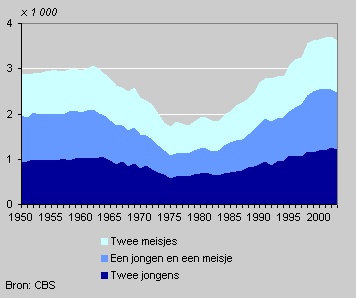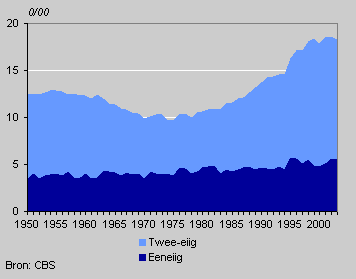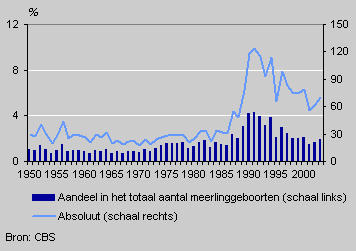Twin births doubled in 25 years

In 2003 some 3.6 thousand twins were born in the Netherlands, twice as many as in the mid-1970s. The increase in twin births is partly due to advanced medical technology, for instance in vitro fertilisation (IVF) a method to help women with fertility problems.
Twin births by sex

Twins
The number of twin births has risen since the mid-1970s.
In 1976 some 1.8 thousand twins were born, in 2003 twin births had doubled to 3.6 thousand. In the mid-1970s one in 103 deliveries were twin births, in 2003 the ratio was one in 55.
Identical and fraternal twin births

More fraternal twins
The share of twins of opposite sex has increased since the early 1980s. The share of fraternal twins has also risen.
Nearly six in every thousand deliveries are identical twins. This proportion has changed little over the last decades. The share of fraternal twins has more than doubled to almost 13 in every thousand deliveries since the mid-1970s. Consequently, the increase in the total number of twins is mainly caused by fraternal twins.
Triplets, quadruplets or quintuplets

Reduced chance of triplets, quadruplets or quintuplets
The number of triplets, quadruplets or quintuplets is very small. In the 1960s, 1970s and 1980s an average of 25 triplets, quadruplets or quintuplets were annually born, i.e. one percent of all multiple births. In 1991 it had risen to 4 percent. The increase was partly due to the application of IVF. During this period four or five fertilised eggs were replaced in the womb.
In the early 1990s the number of fertilised eggs that was replaced in the womb was reduced to two or three. This resulted in a reduction of triplets, quadruplets or quintuplets. Currently no more than two eggs are replaced in the womb.
Ron Tas